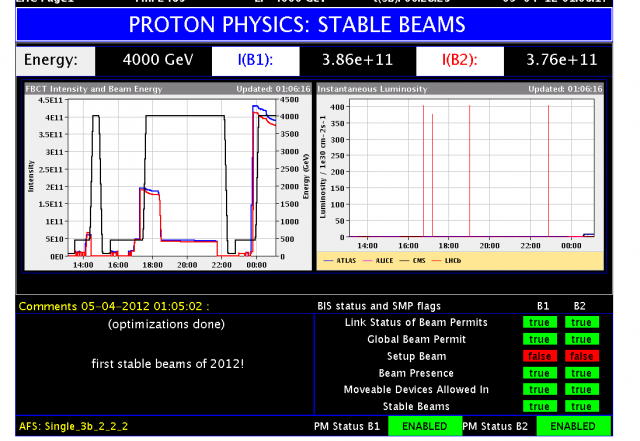Geneva, 5 April 2012. At 0.38am CEST this morning, the LHC shift crew declared "stable beams" as two 4 TeV proton beams were brought into collision at the LHC’s four interaction points. This signals the start of physics data taking by the LHC experiments for 2012. The collision energy of 8 TeV is a new world record, and increases the machine’s discovery potential considerably.
“The experience of two good years of running at 3.5 TeV per beam gave us the confidence to increase the energy for this year without any significant risk to the machine,” explained CERN1’s Director for Accelerators and Technology, Steve Myers. “Now it’s over to the experiments to make the best of the increased discovery potential we’re delivering them!”
Although the increase in collision energy is relatively modest, it translates to an increased discovery potential that can be several times higher for certain hypothetical particles. Some such particles, for example those predicted by supersymmetry, would be produced much more copiously at the higher energy. Supersymmetry is a theory in particle physics that goes beyond the current Standard Model, and could account for the dark matter of the universe.
Standard Model Higgs particles, if they exist, will also be produced more copiously at 8 TeV than at 7 TeV, but background processes that mimic the Higgs signal will also increase. That means that the full year’s running will still be necessary to convert the tantalising hints seen in 2011 into a discovery, or to rule out the Standard Model Higgs particle altogether.
“The increase in energy is all about maximising the discovery potential of the LHC,” said CERN Research Director Sergio Bertolucci. “And in that respect, 2012 looks set to be a vintage year for particle physics.”
The LHC is now scheduled to run until the end of 2012, when it will go into its first long shutdown in preparation for running at an energy of 6.5 TeV per beam as of late 2014, with the ultimate goal of ramping up to the full design energy of 7 TeV.
Find out more:
CERN, the European Organization for Nuclear Research, is the world's leading laboratory for particle physics. It has its headquarters in Geneva. At present, its Member States are Austria, Belgium, Bulgaria, the Czech Republic, Denmark, Finland, France, Germany, Greece, Hungary, Italy, the Netherlands, Norway, Poland, Portugal, Slovakia, Spain, Sweden, Switzerland and the United Kingdom. Romania is a candidate for accession. Israel and Serbia are Associate Members in the pre-stage to Membership. India, Japan, the Russian Federation, the United States of America, Turkey, the European Commission and UNESCO have Observer status.

